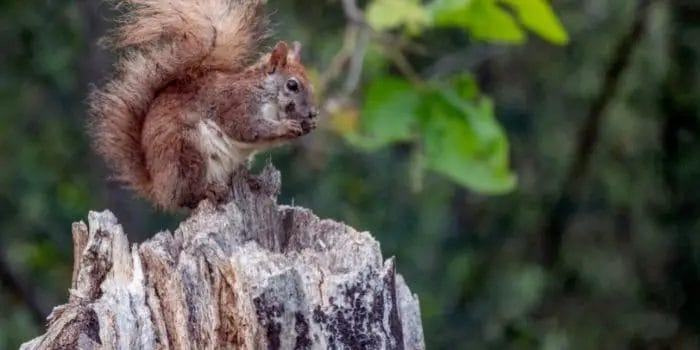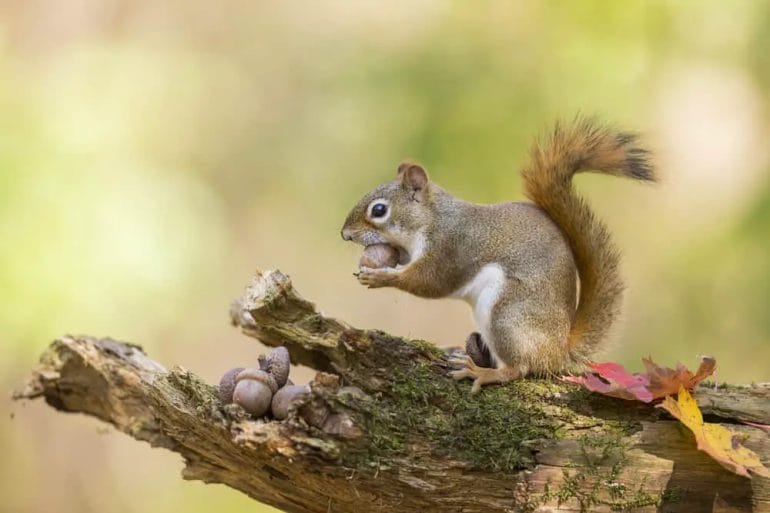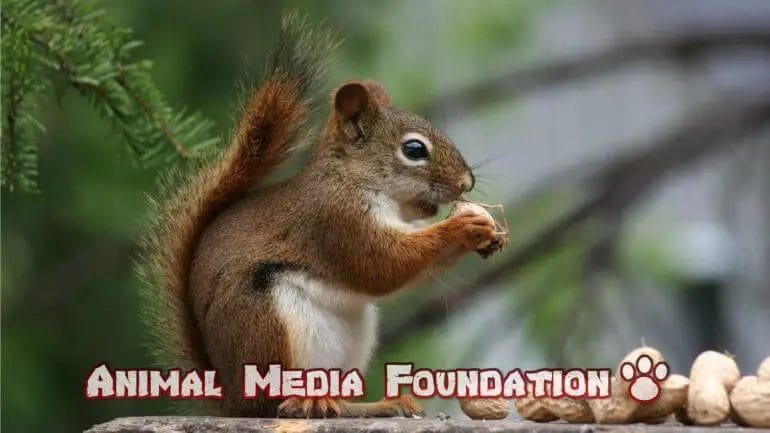Squirrels are known for their love of nuts and seeds, but did you know that they also have a taste for wood?
While squirrels don’t actually eat wood as their primary food source, they do have a habit of gnawing on it. This behavior serves a few different purposes for these furry creatures.

Firstly, squirrels gnaw on wood to keep their teeth trimmed and healthy. Their teeth constantly grow, and gnawing on hard surfaces helps to wear them down and prevent overgrowth. It’s like their own natural dental care routine!
Secondly, squirrels may gnaw on wood to access the tasty treats hidden inside. They are known to create holes in trees to reach the sap, insects, or even bird eggs that they find inside.
Lastly, squirrels also gnaw on wood to mark their territory. By leaving behind their distinctive tooth marks, they communicate to other squirrels that the area is claimed.
So while squirrels don’t feast on wood like termites or carpenter ants, their gnawing behavior serves important purposes for their dental health, foraging, and territorial marking.

How Squirrels Utilize Wood in Their Diet
Squirrels are known for their ability to adapt to various environments and find food sources in unexpected places. One of the interesting aspects of their diet is their consumption of wood. While squirrels are mainly herbivores, they have developed unique adaptations to extract nutrients from wood and incorporate it into their diet.
Wood forms a small but significant part of a squirrel’s diet, especially during times when other food sources are scarce. Here are some ways squirrels utilize wood in their diet:
- Gnawing: Squirrels have powerful incisors that continuously grow throughout their lives. They use their sharp teeth to gnaw on tree branches, bark, and twigs. Gnawing serves multiple purposes for squirrels, including obtaining food, creating nesting sites, and maintaining dental health. By gnawing on wood, squirrels can access the nutritious inner layers and extract essential nutrients.
- Bark Consumption: Squirrels also consume the bark of trees, which contains valuable nutrients. The inner bark, also known as the phloem, is particularly rich in sugars, starches, and fibers. Squirrels strip off the bark using their teeth and consume it to meet their nutritional needs. Bark consumption increases during winter months when other food sources are limited.
- Fungi and Sap: Wood can be a host to various fungi and sap, which squirrels can consume. Some fungi species produce mushrooms that squirrels may nibble on if they come across them. Additionally, squirrels may lick or consume sap that oozes from tree wounds. Sap provides them with an additional source of carbohydrates and fluids.
- Wood-Boring Insects: Squirrels are opportunistic feeders and will target insects that live within wood. They have been observed to dig into decaying wood to access wood-boring insects such as beetles, termites, and ants. These insects not only provide a protein-rich food source but also offer additional nutrients and minerals.
In summary, while squirrels are primarily herbivores, they have developed unique adaptations to utilize wood as part of their diet. Their ability to gnaw, consume bark, access fungi and sap, and feed on wood-boring insects allows them to extract valuable nutrients from wood. This behavior provides squirrels with an additional food source, particularly during times of scarcity. So, the next time you see a squirrel exhibiting its gnawing behavior, remember that it is not only shaping its environment but also fulfilling its nutritional needs.

The Role of Wood in a Squirrel’s Nutritional Needs
Wood is a vital component in a squirrel’s diet and plays a crucial role in meeting their nutritional needs. While squirrels are primarily known for their preference for nuts, seeds, and fruits, wood consumption is equally important for their overall health and well-being. In this section, we will explore why wood is an essential dietary component for squirrels and how it contributes to their nutritional requirements.
1. Dental Health
Squirrels have constantly growing incisor teeth that require regular wear to prevent overgrowth. Gnawing on hard substances like wood helps to keep their teeth in check. The abrasive nature of wood helps to wear down their teeth, preventing them from becoming too long or causing dental issues. By chewing on wood, squirrels maintain proper dental health and ensure they can eat their regular diet of nuts and seeds without any difficulties.
2. Source of Minerals
Wood also serves as a valuable source of minerals for squirrels. As they gnaw on tree bark and twigs, they ingest small quantities of essential minerals such as calcium, magnesium, potassium, and iron. These minerals are necessary for various physiological functions in their bodies, including bone health, muscle function, and enzyme activity. Consuming wood allows squirrels to supplement their mineral intake and ensure optimal bodily functions.
3. Fiber Intake
Another important role wood plays in a squirrel’s diet is providing dietary fiber. While nuts and seeds are rich in fats and protein, they lack sufficient fiber content. Wood, on the other hand, is a good source of dietary fiber, which aids in proper digestion and bowel movement. Fiber helps prevent constipation and promotes a healthy gastrointestinal system. By including wood in their diet, squirrels ensure they have a well-rounded and balanced nutritional intake.
4. Nest Building
In addition to being consumed as a food source, wood also plays a crucial role in squirrel behavior, particularly in nest building. Squirrels construct elaborate nests, known as dreys, using twigs, leaves, and other natural materials. Wood acts as the primary building material, providing structural support and protection from the elements. By gathering and using wood in their nest-building activities, squirrels create safe and secure living spaces for themselves and their offspring.
5. Environmental Enrichment
Wood consumption also serves an important purpose in squirrel behavior and environmental enrichment. Squirrels are highly active and curious creatures, and providing them with access to wood allows for natural foraging and exploration behaviors. Gnawing on wood branches and tree trunks provides mental and physical stimulation, helping to prevent boredom and promote overall well-being in captive squirrels.
In summary, wood plays a vital role in a squirrel’s nutritional needs. It helps maintain dental health, provides essential minerals, contributes to fiber intake, aids in nest building, and offers environmental enrichment. Including wood in their diet ensures that squirrels have a well-rounded and balanced nutritional intake, supporting their overall health and well-being.

Implications of Squirrels Consuming Wood: Benefits and Concerns
Squirrels are known for their ability to survive on a variety of foods, including nuts, seeds, fruits, and even insects. However, recent studies have shown that squirrels also consume wood, which has raised both benefits and concerns among researchers and environmentalists.
1. Nutritional Benefits
One of the surprising benefits of squirrels consuming wood is the potential nutritional value it provides. Wood is rich in cellulose, a complex carbohydrate that is difficult for many animals to digest. Squirrels, with their specialized digestive system, have the unique ability to extract nutrients from wood, especially when other food sources are scarce.
Cellulose is broken down by symbiotic bacteria in the squirrel’s gut, which produce enzymes that help in the digestion process. This allows squirrels to extract energy and nutrients from wood, supplementing their diet during times when food availability is limited.
Additionally, wood consumption can provide squirrels with essential minerals, such as calcium and phosphorus, which are crucial for maintaining strong bones and teeth.
2. Impact on Forest Health
While squirrels’ ability to consume wood may have nutritional benefits, there are concerns regarding its potential impact on forest health. Wood consumption can lead to the accelerated decay of tree trunks and branches, compromising the structural integrity of trees.
When squirrels repeatedly chew on tree bark and wood, they create openings for fungal infections and insect infestations, which can further weaken the trees. This can be especially problematic in forests with a high squirrel population density, as it can result in a higher prevalence of tree diseases and ultimately affect the overall forest ecosystem.
Furthermore, the excessive wood consumption by squirrels can lead to the depletion of deadwood, which serves as an important habitat for various organisms, including insects, fungi, and small mammals. This can disrupt the delicate balance of the forest ecosystem and negatively impact biodiversity.
3. Natural Bark Stripping Behavior
It is important to note that squirrels have a natural behavior called “bark stripping,” where they remove the bark from trees. Bark stripping is primarily driven by the need for nutrients and for building nests, especially during the breeding season.
While bark stripping can cause damage to trees, it is generally considered a natural process that trees can recover from. In fact, some studies suggest that bark stripping can even benefit forests by promoting the growth of new shoots and increasing tree biodiversity.
4. Conservation and Management Strategies
Given the potential implications of squirrels consuming wood, conservation and management strategies are essential to maintain forest health and biodiversity. Some possible strategies include:
- Implementing habitat restoration projects to ensure the availability of diverse food sources for squirrels, reducing their reliance on wood consumption.
- Managing squirrel populations through targeted trapping and relocation programs to prevent overconsumption of wood in specific areas.
- Promoting public education and awareness about the ecological role of squirrels and the potential impacts of wood consumption on forests.
By implementing these strategies, conservationists and forest managers can strike a balance between preserving squirrel populations and mitigating the negative impacts of their wood consumption on forest ecosystems.
Summary
While squirrels consuming wood may have nutritional benefits for the animals, it can also have negative implications for forest health and biodiversity. The accelerated decay of trees and the depletion of deadwood can compromise the structural integrity of forests and disrupt the delicate balance of the ecosystem. However, it is important to recognize that squirrels have a natural behavior of bark stripping, which can promote tree growth and biodiversity. Conservation and management strategies, such as habitat restoration and population management, can help minimize the potential negative impacts of squirrel wood consumption and maintain healthy forests.
Wood-Eating Behavior: Why Do Squirrels Chew on Trees?
Squirrels, with their bushy tails and nimble movements, are a common sight in many parks and gardens. These small rodents are known for their tree-climbing abilities and their tendency to chew on various objects. One of their most peculiar habits is their wood-eating behavior, particularly their habit of chewing on trees. But why do squirrels engage in this behavior? Let’s delve deeper into the reasons behind this seemingly unusual behavior.
1. Dental Health and Maintenance
One of the primary reasons squirrels chew on trees is to maintain their dental health. Squirrels’ teeth grow continuously throughout their lives, much like those of other rodents. Chewing on hard materials, such as tree bark, helps wear down their teeth, preventing them from becoming too long and inhibiting their ability to eat properly. By gnawing on trees, squirrels naturally file down their teeth, ensuring they remain sharp and functional.
2. Food Source
Squirrels are omnivores, which means they consume a variety of foods, including nuts, seeds, fruits, and insects. While trees themselves may not be a direct source of nutrition, squirrels often find food hidden within the bark. Insects, larvae, and sap are sometimes present in tree crevices and provide an additional food source for squirrels. Chewing on trees allows squirrels to access these hidden treasures and supplement their diet.
3. Nesting Material
Another reason why squirrels chew on trees is to collect nesting material. Squirrels build nests, called dreys, in tree branches to provide shelter and protection from the elements. By chewing on tree bark and branches, squirrels create small strips or pieces that they use to line their nests, adding insulation and comfort for themselves and their offspring. Wood provides an abundant and readily available source of nesting material for these resourceful rodents.
4. Territory Marking
Squirrels are territorial animals, and they use scent marking to establish and maintain their territories. Chewing on trees is one way squirrels leave their scent behind. They have scent glands in their mouths, and when they chew on trees, they leave their scent on the bark. This signals to other squirrels that the area has already been claimed and helps prevent conflicts over territory. In this way, wood-chewing serves as a form of communication among squirrels.
5. Dental Exercise and Enrichment
Aside from the practical reasons mentioned above, squirrels also engage in wood-chewing as a form of dental exercise and enrichment. Chewing on different textures and substances helps to strengthen their jaw muscles and alleviate boredom. Wood provides a challenging and engaging material for squirrels to gnaw on, keeping them physically and mentally stimulated.
In summary, squirrels chew on trees for multiple reasons. It serves as a way to maintain their dental health, access hidden food sources, gather nesting material, mark their territories, and provide dental exercise and enrichment. This behavior is a natural and essential part of the squirrel’s lifestyle, showcasing their adaptability and resourcefulness in utilizing the resources available in their environment.
FAQs
1. Do squirrels eat wood?
No, squirrels do not eat wood. While squirrels may chew on wood to sharpen their teeth or create nests, their primary diet consists of nuts, seeds, fruits, and vegetables.
Conclusion:
In conclusion, squirrels do not eat wood as a primary food source. While they may gnaw on wood for various reasons, such as maintaining their teeth or creating nests, their diet mainly consists of nuts, seeds, fruits, and vegetation. Squirrels play an essential role in forest ecosystems by dispersing seeds and contributing to the growth of new trees. Their ability to adapt and thrive in various habitats has made them a fascinating and integral part of the natural world. So, next time you observe a squirrel nibbling on wood, remember that they have a much broader diet that supports their survival and the environment they inhabit.
